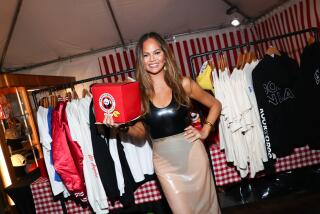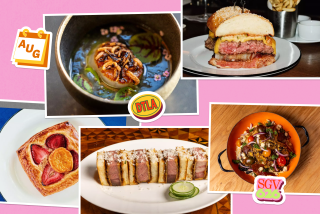Eateries Dish It Out Curbside
- Share via
Christine Crigger wanted fast food without the, well, fast food.
So she pulled up to the Romano’s Macaroni Grill in Northridge and parked in a spot designated for takeout customers. Moments later, a server was placing the order Crigger had phoned in -- penne rustica and a cup of clam chowder -- in the back seat of her silver Toyota Solara.
“I love it,” Crigger, a 32-year-old retail store manager said of Romano’s curbside service, which she uses at least twice a week. Once she pulls up to the restaurant, Crigger said, her order is usually brought to her as “fast as fast food, and I think it’s healthier.”
The demand for healthy, relatively upscale food (read: no hamburgers or chicken nuggets) that’s also convenient is driving casual dining companies such as P.F. Chang’s China Bistro Inc., California Pizza Kitchen Inc. and Brinker International Inc., the Dallas-based parent of Romano’s, to offer drive-up takeout service at a growing number of locations.
“People are increasingly time-starved,” said Bob Sandelman, a Villa Park restaurant consultant. “They want the speed and convenience they’re used to from a fast-food restaurant but the quality they’ve grown accustomed to from full-service chains.”
There’s a perception that casual dining restaurants serve up more nutritious menu offerings, and “with the recent push toward healthy foods, moms and dads are more reluctant to go to fast-food restaurants,” said Michael B. Gottlieb, partner in charge of Ernst & Young’s national restaurant practice. “They would rather go to a casual dining chain that’s easy to take home.”
For a non-fast-food restaurant, offering to deliver to motorists idling in the parking lot is an attempt to fend off McDonald’s Corp., Jack in the Box Inc. and others that have added fancy items such as gourmet salads and sandwiches to compete with their more upscale rivals. So-called fast-casual chains such as Rubio’s Restaurants Inc.’s Rubio’s Fresh Mexican Grill and Carlson Restaurants Worldwide Inc.’s Pick Up Stix, which try to mimic the speed of fast food with the quality of a casual dining restaurant, also pose a threat.
Traditional drive-through windows won’t work in the shopping-center locales typical of many casual dining restaurants, which also take longer to prepare orders than their fast-food rivals. That makes curbside service a logical alternative.
Speed is the key. Romano’s uses closed-circuit TV cameras to alert employees of approaching customers. At the Applebee’s International Inc. chain, which began aggressively expanding its Carside to Go service last year, most curbside orders are ready in 16 minutes or less after being called in. And, the company says, more than 40% of customers are greeted by an Applebee’s employee within 15 seconds of pulling into a designated parking spot.
More than 1,100 Applebee’s outlets offer curbside service; a national advertising campaign is planned for next year when it will be expanded to the rest of the chain’s 1,600 U.S. locations.
“Carside to Go is the fastest growing part of our business,” said Applebee’s spokeswoman Laurie Ellison.
For the most part, packaging elaborate meals -- such as P.F. Chang’s warm duck spinach salad or CPK’s shrimp lettuce wraps -- for the road hasn’t posed major problems. Applebee’s, for example, uses vented covers to keep French fries from going soggy, though the company acknowledges desserts that include ice cream don’t travel particularly well.
Order accuracy, long the bane of takeout eateries, is more of a challenge. On a recent afternoon, for example, a curbside customer at the Woodland Hills P.F. Chang’s complained of an order mix-up. One solution tried at Romano’s is to fit containers with clear plastic lids to make it easier for servers and customers to double-check the contents.
Romano’s began offering curbside service three years ago after a manager at the chain’s Thousand Oaks restaurant approached corporate bosses about testing it. Today, all but 11 of Romano’s 221 outlets will carry lasagna Bolognese and bruschetta to customers in the parking lot. Curbside deliveries account for up to 15% of sales at some locations.
“We like to say, ‘Chefs make it; you take it,’” said John Miller, Romano’s president. “A lot more people want the family hour of sitting around the dinner table, but more often than not the meal is being prepared somewhere other than home.”
Among California chains, Westchester-based CPK has curbside service at roughly half of its outlets, and Calabasas-based Cheesecake Factory Inc. is testing the concept in Boston.
The trend shows signs of spreading to fast-casual chains. About a quarter of the 51 outlets operated by Pei Wei Asian Diners Inc., a fast-casual spinoff of P.F. Chang’s, currently run orders out to cars. Idling motorists are also treated to hand deliveries at Dona Rosa Bakery & Taqueria in Pasadena, a more casual offshoot of the El Cholo Inc. chain of Mexican restaurants.
A lingering concern is that curbside customers come at the expense of traditional, sit-down diners, although chains profess not to be worried that encouraging takeout business will drain lucrative sales of alcohol, which typically can’t be included in to-go orders unless it’s contained in its original packaging.
“With the to-go diner, you’re picking up incremental sales that you would have otherwise missed out on,” said Louis Adams, a spokesman for Brinker, Romano’s parent company. “It’s not like you’re cannibalizing your own business.”
More to Read
Eat your way across L.A.
Get our weekly Tasting Notes newsletter for reviews, news and more.
You may occasionally receive promotional content from the Los Angeles Times.










